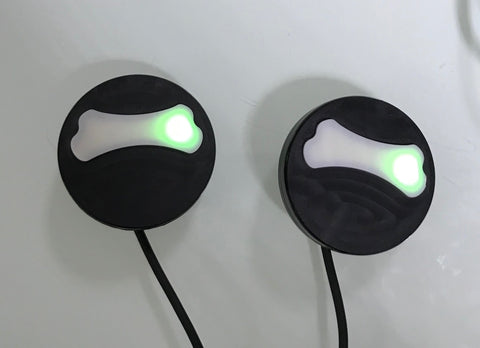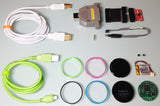Mechanical Prototyping & Low Volume Production
Posted by Denis Bohm on January 28, 2019
With our new Tormach 1100M CNC Mill we can now create mechanical parts out of most materials (plastics, aluminum, steel, brass, etc). This gives us the ability to create full prototypes and also do low volume production in house. We have used this capability to create device enclosures, assembly fixtures, and production stations.
Case Study: Sensor Project
A recent project required a small water-proof sensor. Low volume production was needed to conduct internal studies. An enclosure consisting of two parts was designed. The top part has a white feature that is used for alignment into a strap and doubles as an LED indicator. The bottom part has a magnetic USB connector. The two parts are held together by screws and there is an o-ring in-between to make a waterproof seal.
Top Part
The top part was made by first welding white ABS sheet to black ABS block. These are attached to a custom fixture plate so that multiple tops can be milled in a single pass. The white is milled away from the top to leave just the alignment/indicator feature.

On the back side, the black is milled away to reveal the white indicator feature. There are also alignment features for the internal PCBA, a grove for the o-ring, and holes for metal inserts that will securely hold screws. A custom thermal press hot end, clamp, and adapter plates were made to ease insertion of the tiny metal inserts.

A set of completed top parts:

Bottom Part
The bottom part is milled from a large black ABS sheet. The same custom fixture plate is used to make multiple parts in a single pass.

To complete the bottom part, a magnetic USB connector is glued in place.

Final Assembly
A PCBA and battery are assembled into the top and bottom parts. An o-ring and screws join the two halves to make a waterproof assembly.

The fully assembled device with USB cable attached:

Water Testing
A water tester was used to check each prototype. The prototype is magnetically attached to the mount inside the tester. The tester is pressurized to 3 ATM and the device is submerged into the water. A visual check is done to check for air steams leaking from the device. This device was tested up to 6 ATM and passed all tests.

Production Station
A production station was created for the PCBA in this device. The production station is based on a custom platform that we designed and have used for multiple clients. The custom platform consists of a complete test station with electronics and software - all designed and built in house. To customize the platform for a client, a unique test head is created using our software. The test head consists of a PCB with test point probes and a mechanical component to hold the PCBA under test in place. The software is customized by creating a test script specific to the PCBA.
The production station attached to a computer via USB showing a successful test and programming pass:

The custom test heads are the black parts in the image below. The top test head contains all the test point probes in this case. The bottom test head holds the PCBA securely in place.

Conclusion
The addition of the mill rounds out our capabilities so that full devices can be made in house including mechanicals, electronics, firmware, and apps.



